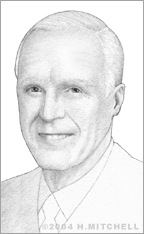John Backus
John Backus developed Fortran, or Formula Translator, one of the first general purpose, high-level computer programming languages. This widely used language made computers practical and accessible machines for scientists and others without requiring them to have deep knowledge of the machinery.
Backus was born in Philadelphia on Dec. 3, 1924 and grew up in Wilmington, Delaware. His affluent family sent him to the prestigious Hill School in Pottstown, Pennsylvania, but he was not a particularly disciplined student, and his grades were poor. Nevertheless, he graduated in 1942 and attended the University of Virginia. He was expelled during his freshman year for poor attendance and joined the U.S. Army.
While in the Army, Backus performed well on an aptitude test for medical skills and was sent to Haverford College to study medicine. Meanwhile, he was diagnosed and treated for an operable brain tumor. He continued to study medicine at Flower and Fifth Avenue Medical School in New York, but just nine months later, he dropped out. Unsure of what he wanted to do with his life, he rented an apartment in New York and thought he would learn how to build a hi-fi set for himself. He enrolled at a radio technician’s school. It was there that he discovered his aptitude for mathematics.
Shortly thereafter, Backus enrolled at Columbia University to study math. He completed his degree in 1949 and was hired by IBM in 1950 to work on the Selective Sequence Electronic Calculator (SSEC), one of IBM’s early electronic computers. He worked on the project for three years. Early on, part of his job was to attend the machine and fix it when and if it stopped running. Programming the machine was difficult, as there was no organized system of doing it. Backus invented a program he called Speedcoding to streamline the process. The program included a “scaling factor,” which allowed numbers of all sizes to be easily stored and manipulated.
In 1953, IBM approved Backus’s outline for a programming language for its new computer, the 704. He hired a team of programmers and mathematicians and set out to design a language as well as a translator. A translator, Backus felt, would be the key to making the computer easier and faster to work with. It would eliminate the need for tedious, time-consuming hand-coding that was typical of computer programming at the time. Essentially, this device would translate the information given through the language created for the users to understand into the binary information that the machine would understand.

Backus and his team published a paper in 1954 called “Preliminary Report, Specifications for the IBM Mathematical FORmula TRANslating System, FORTRAN.” It would take them two years to complete the language’s compiler, which was provided with each IBM 704 installation. Now nearly 50 years later, Fortran is still widely used. Over time and using a great deal of user feedback, the system has become much more efficient and many of the early “bugs” have been eliminated.
After completing the Fortran system, Backus created the Backus-Naur Form (or BNF), a standard notation that describes grammatical rules for high-level languages, in 1959. It is used in a number of programming languages today. He continued to work on language simplification throughout his career, working mainly for IBM’s San Jose Research Laboratory and Almaden Research Center. He was named one of the first IBM Fellows in 1963.
Backus was awarded the National Medal of Science in 1976 and the prestigious Turing Award in 1977. He was also the 1993 recipient of the Charles Stark Draper Award. He retired in 1991 in Ashland, Oregon, where he died on March 17, 2007.


